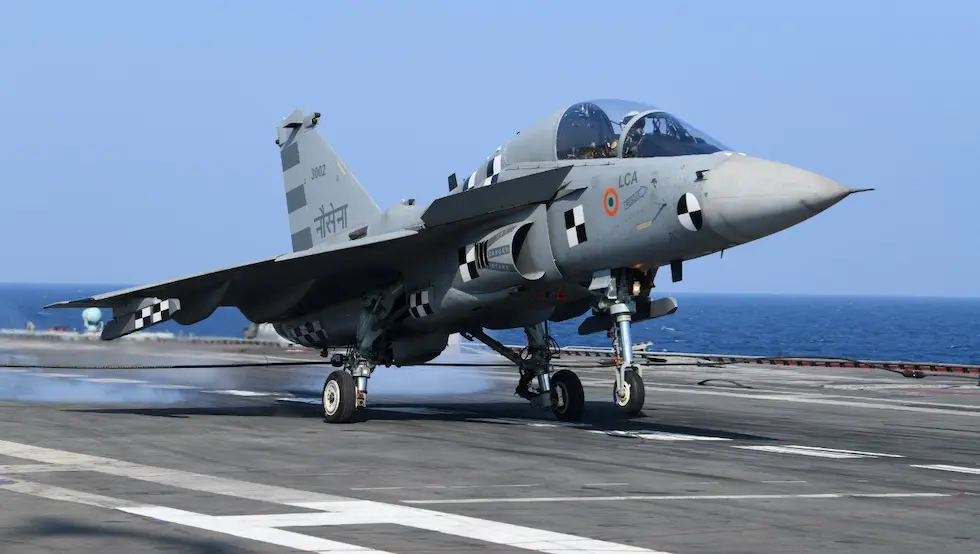
India approves a ₹62,000 crore deal for 97 Tejas Mark 1A fighter jets, boosting indigenous defence manufacturing and replacing ageing MiG-21s (photo source Wikipedia)
Tejas Deal Soars – India’s defence landscape is undergoing a seismic shift with the recent approval of a ₹62,000 crore deal to procure 97 Tejas Mark 1A fighter jets. This landmark decision not only strengthens the Indian Air Force (IAF) but also propels the nation’s Make in India and Atmanirbhar Bharat initiatives to new heights. Here’s a deep dive into what this deal means for India’s military capabilities, indigenous manufacturing, and strategic autonomy.
A Historic Leap: The Tejas Mark 1A Deal Unveiled
In a high-level meeting held on August 19, the Indian government greenlit the acquisition of 97 Light Combat Aircraft (LCA) Tejas Mark 1A jets, manufactured by Hindustan Aeronautics Limited (HAL). This follows an earlier order of 83 Tejas jets worth ₹48,000 crore, bringing the total fleet to 180 indigenous fighters.
The Tejas Mark 1A is a significant upgrade over its predecessors, featuring advanced radar systems, electronic warfare capabilities, and enhanced avionics. With over 65% indigenous components, the aircraft embodies India’s push for self-reliance in defence production. HAL’s ramped-up production capacity will ensure timely delivery, with the first batch expected to roll out within the next few years.
This procurement is not just a military transaction, it’s a strategic statement. It signals India’s intent to phase out its ageing MiG-21 fleet, which has served the nation for decades but is now set to retire by September. The Tejas jets will replace these legacy aircraft, ensuring the IAF remains combat-ready with modern, homegrown technology.
Make in India Takes Flight: Boosting Indigenous Defence Manufacturing
The Tejas deal is a cornerstone of Prime Minister Narendra Modi’s Make in India initiative, particularly in the defence sector. HAL, the state-run aerospace giant, stands at the center of this transformation. With this order, HAL is poised to generate massive employment opportunities and stimulate growth across hundreds of small and medium enterprises (SMEs) involved in the supply chain.
The ripple effect of this deal extends beyond HAL. It energizes India’s entire defence ecosystem, from avionics and radar manufacturers to composite material suppliers and software developers. The Defence Ministry and Air Headquarters have strongly backed the programme, recognizing its potential to transform India into a global hub for aerospace innovation.
Moreover, HAL is preparing for future orders, including over 200 Tejas Mark 2 jets and a similar number of fifth-generation Advanced Medium Combat Aircraft (AMCA), further solidifying India’s long-term vision for indigenous air power.
Strategic Edge: Why Tejas Mark 1A Matters
The Tejas Mark 1A isn’t just a symbol of national pride, it’s a tactical asset. Designed for agility, speed, and precision, the aircraft is equipped to handle a wide range of missions, from air-to-air combat to ground attack. Its upgraded AESA radar, digital flight control systems, and mid-air refueling capabilities make it a formidable contender in modern aerial warfare.
Replacing the MiG-21s with Tejas jets also enhances operational safety and mission effectiveness. The MiG-21s, though iconic, have faced criticism for their outdated technology and high accident rates. The transition to Tejas marks a generational shift in India’s air combat capabilities.
Additionally, the Tejas programme has garnered international attention. Former Air Chief Marshal VR Chaudhari announced the expansion plans during a visit to Spain, underscoring India’s growing ambitions in global defence diplomacy. With export potential on the horizon, Tejas could soon become a key player in international fighter jet markets.
Tejas Deal Soars – A Vision for the Future: Atmanirbhar Bharat in Action
This deal is more than a procurement—it’s a manifestation of India’s strategic doctrine of self-reliance. Under the Atmanirbhar Bharat mission, India aims to reduce dependence on foreign defence imports and build a robust domestic manufacturing base. The Tejas programme exemplifies this vision, proving that India can design, develop, and deploy world-class military technology.
Prime Minister Modi’s personal endorsement of the Tejas jet—having taken a sortie in its trainer variant—adds symbolic weight to the programme. It reflects the government’s commitment to nurturing indigenous innovation and showcasing India’s technological prowess on the global stage.
As HAL gears up for future projects, including the LCA Mark 2 and AMCA, the Tejas deal serves as a launchpad for a new era in Indian aerospace. It’s a bold step toward strategic autonomy, economic growth, and national security.
Conclusion
India’s ₹62,000 crore Tejas Mark 1A deal is not just about fighter jets, it’s about forging a future where India controls its skies with homegrown strength. From phasing out legacy aircraft to empowering SMEs and asserting global presence, this move is a masterstroke in defence strategy and industrial policy. As the Tejas jets take flight, so does India’s ambition to become a self-reliant superpower in aerospace and defence.
Also read – Tejas Mk1A Deal Propels India’s Air Power into a New Era: Skybound Supremacy
India’s Tejas Mk-1A Takes Flight: A Strategic Setback for China and Pakistan’s Air Supremacy Dreams
Tejas Mk1A Takes Flight: India’s Indigenous Jet Challenges Global Giants in 2025 Skies
Stay updated with latest updated news blogs on Rapido Updates.